| Pages:
1
2
3 |
SamirCanada
Moderator
     
Posts: 3404
Registered: 6-4-2004
Member Is Offline
|
|
Ok so all this research into vine is not wasted after all.
especially if you make a oud out of it John!
I got scared that all you had done so far was down the trash.
Interesting subject fellas. keep up the good stuff!!
|
|
|
jdowning
Oud Junkie
    
Posts: 3485
Registered: 8-2-2006
Location: Ontario, Canada
Member Is Offline
Mood: No Mood
|
|
Nothing is wasted Samir. If it can be proven that Dr Farmer had mis-interpreted the original manuscript and incorrectly identified 'mais' as vine
wood, then this may be important progress in researching the history of the oud that otherwise may never have come to light. As ALAMI has indicated,
positive identification of the woods described by the authors of these centuries old texts may be difficult, if not impossible, to determine with
certainty today. Not that we should not try. So, Farmer may still be correct - but, nevertheless, I think that ALAMI's alternative interpretation is
convincing. All 'grist to the mill' in the quest for historical truth!
As for the vinewood I intend to press on in preparing my collected samples for use, after seasoning, as the wood - even if eventually proven not to
have been used in early ouds - is sufficiently interesting in its own right to warrant continuing further investigation.
ALAMI has suggested that the 'mais tree' might be a species of the hackberry tree. The attached image shows some characteristics of the hackberry tree
(Canadian) that may help in positive identification of the tree elsewhere. Grid scale is
1 inch or 25.4 mm

|
|
|
jdowning
Oud Junkie
    
Posts: 3485
Registered: 8-2-2006
Location: Ontario, Canada
Member Is Offline
Mood: No Mood
|
|
The attached macro images of American Elm (Ulmus americana) may help further in identifying Hackberry (Celtis occidentalis) which has a very similar
cell structure to the Elm family of woods. Elm and Hackberry are identified by the characteristic wavy bands of the latewood cells (the small diameter
cells). This arrangement cells is known as ulmiform, from Ulmus (elm).
The earlywood cells (the large ones) in the American elm sample shown here are characteristically arranged, more or less, in a single row whereas in
hackberry the early wood is more than one pore wide - as also found in Slippery Elm (Ulmus rubra). Both hackberry and elm are ring-porous woods.
To distinguish between hackberry and elm, the heartwood of hackberry is coloured cream to light brown or yellowish grey whereas the elm heartwood is
brown to reddish brown. Also in hackberry the radial 'rays' can be up to 10-12 cells wide with some always wider than 7 cells whereas in elm the
largest rays are generally 4-5 cells wide but never wider than 7 cells.
(Information from 'Identifying Wood' by Bruce Hoadley)
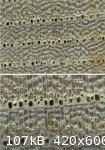
|
|
|
jdowning
Oud Junkie
    
Posts: 3485
Registered: 8-2-2006
Location: Ontario, Canada
Member Is Offline
Mood: No Mood
|
|
This image shows the cell size of the American Elm sample - the reference scale is in millimeters.
For information, this sample of elm is from my woodlot. It is a very common tree subject unfortunately to elm disease that kills a number of elms each
year. I burn a lot of small diameter dead elm for winter stove wood. Larger trees (up to 30 inches or 76 cm in diameter) may be slab cut with a
portable chainsaw mill into boards 2 inches or more in thickness for air drying and use as timber. I have quite a quantity that has been drying for
years. So the good news is that I have plenty of elm from which to select rib stock for making early oud replicas - if we can be reasonably sure that
this wood may have been used in the past.
As for confirming that the Mais tree in the images posted by ALAMI is a species of Hackberry, it will be necessary first to obtain a sample of the
wood (a piece of a small diameter branch or twig) and examine the grain structure with a 10X magnifying lens. Also to examine the leaves, fruit and
bark.
To prepare wood specimens for examination of the cell structure I simply smooth the cross grain section with a sharp, low blade angle plane to produce
a clean cut. For small sections of wood a single edge razor blade may also be used to produce a clean cut across the grain. The images were taken with
a Canon A470 digital camera. This is described as an "Entry Level" camera but is sophisticated and versatile and relatively low cost (around $130).
One, of many reasons that I chose this model was because of its super macro, close up facility as evident in the images posted. The posted image files
have been considerably compressed in size so some detail and crispness of the original images has been lost.
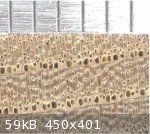
|
|
|
jdowning
Oud Junkie
    
Posts: 3485
Registered: 8-2-2006
Location: Ontario, Canada
Member Is Offline
Mood: No Mood
|
|
The last stage of preparing the vine wood samples for seasoning is to 'sticker' each three piece section. 'Stickering' means placing strips between
each cut layer to allow air to circulate and allow drying of the wood. Each length of vinewood stem has been 'stickered' with strips of spruce about
3mm thick at each end and in the centre and the whole lot bound tightly together with three double loops of 14 gauge wire tensioned - like a
tourniquet - with a metal rod.
The sections will now be stored in a granary loft to dry over the coming winter period.
This is a seasoning method that might be used for small diameter logs of other wood species.
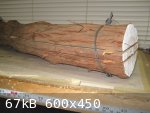
|
|
|
ALAMI
Oud Junkie
    
Posts: 643
Registered: 12-14-2006
Location: Beirut
Member Is Offline
Mood: No Mood
|
|
John, just allow me to say that you have this talent of making any subject you approach interesting and inspiring, your curious, scientific, open and
yet passionate mind is an inspiration.
I learned and still learning a lot from you and I am sure that most of the guys here think the same... thank you.
Back to wood,
I asked someone to give a look to an arabic botanical encyclopedia and here's what I got:
- Sayam is also called SAJ or SAG and it seems that it was always imported from india and was also used for boats and weapons.
- Al Dardar in old arabic is "Flowering Ash" that is Fraxinus ornus L very common in the Middle East
- Al Zan is beech
Mais is still the most mysterious one,
As Samir said, we are all eager to see this investigation, along with the "old woodcut" and the one on glue transform into the first replica of a
medieval oud by John Downing.
|
|
|
jdowning
Oud Junkie
    
Posts: 3485
Registered: 8-2-2006
Location: Ontario, Canada
Member Is Offline
Mood: No Mood
|
|
Thank you for your kind words ALAMI. I also have learned a lot since joining the forum and will continue to do so thanks to the interest of
contributing members. It is a pleasant and fulfilling journey of discovery for me. So the sentiments are very much reciprocal. Thank you!
My first oud (or two) will be a recreation of a medieval oud (from the 'woodcut') - based upon the best research data currently available - thanks to
this wonderful forum. Subject of a new topic for next year.
Just for information, a slight diversion mentioned earlier in this thread and while on the subject of identifying wood species by cell structure - the
damaged pegbox backplate of the old oud that I am currently (very slowly!) restoring - that I thought might be Mahogany - has been microscopically
examined and compared to the data and images in Bruce Hoadley's book. This is a very small sample (about 2 mm thick) and I am an absolute beginner
(but eager to learn) in this fascinating field of wood identification. The backplate would seem to be very close in cell structure to 'Central
American Mahogany' (Swietenia spp) as defined by Hoadley.
The attached image of the end grain of the back plate has been rotated so that the radial rays are vertical. Not the clearest of images but note the
distinctive tangential rings and cells containing dried red gum deposits which may distinguish this from African Mahogany (Khaya spp)
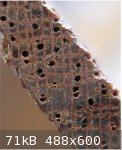
|
|
|
jdowning
Oud Junkie
    
Posts: 3485
Registered: 8-2-2006
Location: Ontario, Canada
Member Is Offline
Mood: No Mood
|
|
Dr Farmer also mentions another wood used to construct ouds in his translation of the 14th C Persian manuscript Kanz al-tuhaf .... "The best wood for
this purpose is 'shah' which comes from Darya-har, although sometimes the wood of Sardia is found good"
Any suggestions as to what woods these might be?
|
|
|
jdowning
Oud Junkie
    
Posts: 3485
Registered: 8-2-2006
Location: Ontario, Canada
Member Is Offline
Mood: No Mood
|
|
...... 'shah' meaning 'king of kings' (?). Another royal wood!
Another difficulty in identifying the woods described by these early writers may be in the two stage translation from the original Arabic or Persian
text into phonetic and then into a modern Western language? Much may be lost in the translation so there is probably a need to examine the original
source documents as well - which is always a good idea - easier said than done, however.
Thanks to ALAMI's most recent investigation, one wood that does seem to be consistent in translation is 'Al Zan' or beech wood. This is a wood that I
have seen used successfully by modern day lute makers but not sure if any surviving early lutes were made from beech. Ash was used in early16th C
lutes. Usually fairly plain in its grain pattern, Ash is sometimes found with figuring similar to that more commonly found in Maple - which likely
makes the wood harder than plain Ash (?). As far as I know it is the figured Ash that was used by the early luthiers.
I am not familiar with the 'Flowering Ash' tree or its wood. Popular for ornamental planting in gardens in the West it would seem.
|
|
|
jdowning
Oud Junkie
    
Posts: 3485
Registered: 8-2-2006
Location: Ontario, Canada
Member Is Offline
Mood: No Mood
|
|
For information and comparison - now that 'Ash' may be a possibility - the attached images show the end grain cell structure of a sample of White Ash
(Fraxinus americana) from my woodlot (the top image) and Black Ash (Fraxinus nigra) recovered from a floor joist in a demolished local building built
during the 19th C.
Ash is a ring porous species - like Elm/Hackberry - and is quite similar to the latter two species in cell structure except that it does not have the
distinctive 'ulmiform' wave pattern of the latewood cells (although the white ash latewood cells do, somewhat vaguely, join together, in wavy
bands.
I would expect that 'Flowering Ash' (Fraxinus ornus L) would have a similar cell structure to White/Black Ash.
As an aside, I am very pleased with the macro image capability of this, relatively low cost, Canon A470 digital camera (one of my latest technical
'toys') - that can be used (among many other things, including video image recording) as a low power digital microscope. It can see details that I, in
old age, now longer can - even with a optical 10X lens.
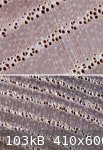
|
|
|
jdowning
Oud Junkie
    
Posts: 3485
Registered: 8-2-2006
Location: Ontario, Canada
Member Is Offline
Mood: No Mood
|
|
Continuing with more (compressed) macro images of the cell structure of woods mentioned in this thread - just for information and comparison - here is
an example of European Beech wood (Fagus grandifolia).
Beech (and Sycamore) are classified as "Diffuse- Porous" woods. The pores are small and in irregular multiples and clusters evenly distributed
throughout most of the growth ring.
Note that my set up for taking these these digital images is quite 'rough and ready' - the camera simply being pressed firmly to my work bench and
aligned to the specimen by eye, allowing the camera on 'auto' to undertake proper exposure, focus etc. - less than ideal for macro photography where
focus is critical due to lack of depth of field. Also, preparation of the specimens is less than ideal - simply using a sharp plane to prepare the
wood section is fairly inaccurate. So, in these images scratch marks are in evidence as well as some extraneous fibers from paper towels used to wipe
the prepared surfaces. However, although they do not compare in clarity to the photos in the Hoadley book - they, nevertheless give a pretty good idea
of of the typical cell structure of each wood species.
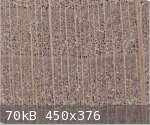
|
|
|
jdowning
Oud Junkie
    
Posts: 3485
Registered: 8-2-2006
Location: Ontario, Canada
Member Is Offline
Mood: No Mood
|
|
Walnut - in this case Black Walnut (Juglans nigra). Walnut is classified as Semi-Ring-Porous with fairly large early wood cells decreasing gradually
to quite small latewood cells. Black Walnut is very similar to the European variety (Juglans regia) except that the latter is usually lighter in
colour and lacks the pore size contrast of Black Walnut.

|
|
|
jdowning
Oud Junkie
    
Posts: 3485
Registered: 8-2-2006
Location: Ontario, Canada
Member Is Offline
Mood: No Mood
|
|
East India Rosewood (Dalbergia latifolia) - classified as 'Diffuse-Porous" with variable sized cells, large and small, irregularly distributed. Growth
rings indistinct.

|
|
|
jdowning
Oud Junkie
    
Posts: 3485
Registered: 8-2-2006
Location: Ontario, Canada
Member Is Offline
Mood: No Mood
|
|
Watching a TV program on New Year's Eve about the great Egyptian pyramid builder Sneferu, first pharaoh of the fourth dynasty (2613 BC to 2589 BC) I
was interested to note that surviving inside Sneferu's less than successful "Bent Pyramid" are some original timbers supporting the cracked ceiling of
one of the chambers. The commentator said that the timbers - over 4000 years old - had come from southern Lebanon.
On investigation, one reliable source confirmed that the timbers were cedar wood and that there were also fragments of a cedar coffin inside the
pyramid.
When ALAMI posted two possible alternative woods to Farmer's 'Vine' - Hackberry and Cedar of Lebanon - I was less than diligent in looking into cedar
as I assumed that the woods referred to by Farmer were all hardwoods used for making oud bowls - which discounted cedar as a possibility in my mind.
However, checking Dr Farmer's translation again there is no such specific use mentioned - so the woods mentioned by him might be either soundboard
woods or bowl woods.
Further research revealed that, Sneferu, from an inscription on the 'Palermo Stone', tells of importing 40 shipments of cedar logs from Lebanon (i.e.
the forests on Mount Lebanon) for making ships and the doors of his royal palace. The Egyptians believed that cedar wood represented eternal life.
Cedar resin and sawdust was used in the mummification process for their kings.
Phoenician king Hiram of Tyre provided cedar logs from Mount Lebanon for the building of the famous temples and palaces of David and his son Solomon -
kings of Judah and Israel - structures with cedar columns, support beams and wall and ceiling panelling. The altar of Solomon's temple (completed in
960 BC) was made from cedar. A main room in one of his palaces was named "The Hall of the Forest of Lebanon".
The recently excavated royal tomb, supposed to be that of Midas, king of Phrygia (late 8th C) at Gordion in Turkey is built in part of cedar logs and
contains a coffin carved from a huge cedar log.
Following a military invasion of Syria, Shalmaneser III (9th C BC) demanded tributes from one prince to be paid in part with two hundred cedar logs.
Another prince had to provide two hundred cedar logs and one hundred cedar logs each year thereafter. A third prince was required to supply three
hundred cedar logs annually.
King Sargon II (late 8th C) regarded cedar timber as a valid taxation payment.
So, the Cedar of Mount Lebanon was a very valuable wood in ancient times - both from a religious and spiritual point of view as well as one that might
easily be found in "the treasury of kings" because of its monetary value.
Not only that, but until fairly recently, Cedar of Lebanon was widely used as a soundboard wood for ouds. Sadly, the Cedars are now in serious
decline, a threatened species - victim of over harvesting and other poor forestry practices as well as environmental pressures.
Given this information, of the three condenders - Vine, Hackberry and Cedar of Lebanon (Cedrus libani), I would now rank cedar as the most likely
translation of 'Mais'.
Cedar of Lebanon is a fairly heavy softwood with a specific gravity of about 0.52. Interestingly Farmer translates 'Sharbin' as 'Larch' wood, an oud
soundboard wood mentioned by
14th C writer Ibn al-Tahhan. Larch is also a heavy softwood with a specific gravity of about 0.52. More dense soundboard woods would imply thinner
soundboards than those made from spruce most commonly used on ouds today.
For completeness the attached macro images show the transverse cell structure of Cedrus libani. (source 'Manual of Traditional Wood Carving', Paul N.
Hasluck, 1911, Dover Publication reprint and 'Nitrogen Cycling by Wood Decomposing Soft-rot Fungi in the King Midas Tomb, Gordion, Turkey', 2001, by
Filley, Blanchette, Simpson and Fogel).
Presumably, Cedar of Lebanon, of a quality suitable for making soundboards, is no longer available? If anyone knows of a reliable source - let us all
know!
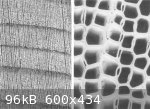
|
|
|
jdowning
Oud Junkie
    
Posts: 3485
Registered: 8-2-2006
Location: Ontario, Canada
Member Is Offline
Mood: No Mood
|
|
Three more historical references linking Cedrus libani with kings, their treasuries, palaces and temples and the Lebanon.
Assyrian king Ashurnasirpal (883 to 859) left detailed records of logging operations in the Lebanon and Amanus. His men cut four species of trees
including Cedrus libani.
King of Babylon, Nebuchadnezzar (605 BC to 562 BC) left an inscription in the Wadi Brisa, (adjacent to the cedar forests of the Lebanon) where he
claims to have built a road and a canal " to carry, like reed stalks, mighty cedars, high and strong, of precious beauty and of excellent dark quality
- the abundant yield of Lebanon ".
At a much later date (?), cedar for the treasury doors at Eleusis (Central Greece) was supplied at great cost by an overseas trader and merchant from
Knidos in Caria. (source unknown)
|
|
|
patheslip
Oud Junkie
    
Posts: 160
Registered: 5-24-2008
Location: Welsh Marches
Member Is Offline
Mood: smooth
|
|
I wonder if the 'flowering ash' could be Sorbus cashmiriana or one of the other mountain ash species rather than a Fraxinus. European and Asian ashes
don't have obvious 'flowers' but are wind pollinated; trees like the cashmiriana have pretty petals.
The leaves are superficially like those of Ash, odd pinate, and so sometimes confused, but the branching is alternate rather than opposite. The
trees are a lot smaller too, though very pretty in spring and early winter.
(I'll take my gardener's hat off now.)
The thread is fascinating. Please keep it up.
|
|
|
jdowning
Oud Junkie
    
Posts: 3485
Registered: 8-2-2006
Location: Ontario, Canada
Member Is Offline
Mood: No Mood
|
|
Flowering Ash (Fraxinus ornus L) as identified by ALAMI is more likely, in my opinion, as it is a true ash so will probably have similar cell
structure and properties to other Ash species (like Fraxinus americana and Fraxinus nigra previously posted). Ash ribs are found in surviving early
16th C lutes so Ash was likely also used for early oud construction.
Most ash trees have modest flowers appearing in early spring with the leaves but likely not as prominent as those of the flowering ash?
|
|
|
Luttgutt
Oud Junkie
    
Posts: 578
Registered: 1-10-2009
Location: Norway
Member Is Offline
Mood: Curious
|
|
Hi guys!
I am new here, and just wanted to say that I find this completly fascinating. I used all my lunsh brake reading :-)
Thanks
|
|
|
theodoropoulos
Oud Junkie
    
Posts: 177
Registered: 12-21-2008
Location: Greece
Member Is Offline
Mood: No Mood
|
|
mr jdowning you are an encyclopedia!!!
i always like to learn from you!!

|
|
|
jdowning
Oud Junkie
    
Posts: 3485
Registered: 8-2-2006
Location: Ontario, Canada
Member Is Offline
Mood: No Mood
|
|
Thanks for your interest!
This reminded me to check progress with the seasoning of the vine wood stems. The stems have been 'stickered', bound with wire and stored for the past
4 months in a dry unheated loft with good air circulation.
From the images it can be seen that in spite of sub zero winter conditions the wood has dried fairly rapidly - which seems to be a characteristic of
vine wood.
The small diameter stems that were split in half before drying show the typical problem of cracks starting from the core or pith of the sample. The
pith of a log should always be cut away before seasoning to avoid this problem.
The larger diameter stems that were cut in three parts, with the pith isolated in the central section, show little degradation due to drying.
This is just for interest as it is unlikely that the vine now will be used for building an oud - but we will see how the wood looks after being cut
into veneer slabs.
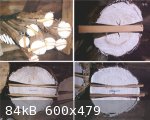
|
|
|
DaveH
Oud Junkie
    
Posts: 526
Registered: 12-23-2005
Location: Birmingham, UK
Member Is Offline
Mood: No Mood
|
|
I happened to hear something today on an environmental programme on the radio and thought of this thread. It might provide some sort of a clue to the
confusion re vinewood. Apparently, almost all the Elms in Europe are clones taken from very few trees in roman times (hence their susceptiblity to
Dutch elm disease). They were spread from Spain right up to England (and possibly further around the mediterranean??) because of their use as leaf
fodder and as supporting plants for vines.
I see from Wikipedia that Hackberry was formerly classified in the same family as Elms. However, the genetic relationship is more tenuous and, under
the APG II system (introduced in 2003), the Hackberry (Celtis) genus was moved from the Ulmaceae family to the Cannabaceae.
So just a tenuous idea, but it might be possible that Farmer is somehow getting confused between vine and the tree (or a relative of it) used as part
of the same agroforestry system. His translations do not seem to be universally reliable (viz sysam, which is actually Dalbergia Sisoo).
|
|
|
jdowning
Oud Junkie
    
Posts: 3485
Registered: 8-2-2006
Location: Ontario, Canada
Member Is Offline
Mood: No Mood
|
|
Thanks DaveH. A potentially interesting twist to the tale.
I knew that the early methods for culture of grape vine used living trees for support (quite a 'work out' when harvesting the grapes I imagine!) but
not that Elms were preferred.
Checked the Wikipedia link and found that the common Hackberry that grows in my 'neck of the woods' is still classified as Ulmaceae - a typo error
perhaps or maybe the latest classification is too recent to have gained general acceptability? So Hackberry is now a species of hemp. Hmm!
Of course, it is impossible now to establish how Farmer concluded that vine was the wood in question. Unfortunately, the popular name for a species of
wood or tree can be so variable across time, region, language and culture that it is almost impossible to know for sure what wood the early writers
were referring to - if indeed the scribes knew themselves.
My first choice in this case - from the 'evidence' - is still Cedar of Lebanon - but who really can be certain.
Dr Farmer probably was no expert in wood identification but I think that, in general, his work in translating the early Arabic and Persian texts
concerning ouds is still a useful reference source today.
The other area of research fraught with difficulty in translation is the question of early measurement - a complex and interesting field of study in
its own right. So the dimensions of ouds given by Farmer and other researchers of his time should also be subject to critical examination.
I suspect that Elm might be a suitable oud or lute bowl material but do not know if it was ever used historically - judging from surviving early lutes
at least.
|
|
|
jdowning
Oud Junkie
    
Posts: 3485
Registered: 8-2-2006
Location: Ontario, Canada
Member Is Offline
Mood: No Mood
|
|
The vine samples have now been seasoning for 17 months but the results are not promising - the wood twisting and bending as it dries even when
constrained - the forces generated being sufficient to break the binding wires. So there is no hope of being able to cut the wood into veneer for
instrument work.
On the other hand, one sample was cut into veneer of
about 2 mm thickness and the bundle clamped between two flat boards to dry. On being released from the clamping pressure after 17 months, the veneers
are flat - so could possibly be made into oud ribs. However, based on the results of these trials, I do not think that it is worthwhile continuing
further with this investigation into vine wood as a material for instrument work
As a final test and to take the evening chill off the air, the vine samples were fed to the wood stove - with good effect.
"Vine wood is only good for burning" the author of Ezekiel in the Old Testament tells us (Chapter 15). How true.
So, here endeth the lesson!!

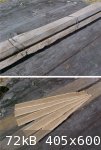
|
|
|
Luttgutt
Oud Junkie
    
Posts: 578
Registered: 1-10-2009
Location: Norway
Member Is Offline
Mood: Curious
|
|
This was actually THE post that got me hoocked to this wanderful forum!!
So I want to wish this project a good night dream...
And a big thanks to you jdowning
The wood might be dead, but the oud is alive.
|
|
|
| Pages:
1
2
3 |